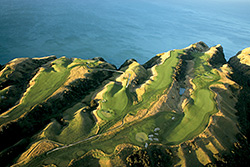
Golf’s two main protagonists in the course-ranking arena are now going head-to-head on the global stage, and while they don’t agree on everything, they exhibit considerable common ground when it comes to rising reputations of New Zealand’s Cape Kidnappers GC, Kauri Cliffs GC, and Asia-Pacific courses generally.
In January 2014, Golf Digest issued its first-ever global top 100, (“The World’s Greatest 100 Golf Courses“) and New Zealand’s two most heralded tracks both landed in the top 40: Tom Doak-designed Cape Kidnappers at #22, and David Harman-designed Kauri Cliffs at #39. Of the 100 featured, 18 courses hailed from the Asia-Pacific region, the highest percentage ever achieved, including top 100 debuts from courses in China, Korea, Indonesia and Australia.
Golf Digest in many ways pioneered the idea of course ranking, in 1966. Based in the U.S., the magazine property — which owns and/or partners with some 27 international editions — had previously formulated only a top 100 for the United States, complemented by a “Top 100 Courses Outside the U.S.”, last issued in 2012.
Its main competitor in the global course-ranking gambit, GOLF Magazine, issued its latest “Top 100 Courses in the World” in September 2013, something it has done every other year since the late 1970s. Cape Kidnappers currently ranks #38 in this balloting, while its sister course, Kauri Cliffs (both are owned by American hedge fund legend Julian Robertson), sits at #74.
“Selfishly, we’re pleased that Golf Digest has opted to both issue a global top 100 and rank our golf courses so highly — we can now safely say that we offer discriminating golfer travelers two of the top 40 courses in the world,” said Ryan Brandeburg, director of golf at Cape Kidnappers GC (www.capekidnappers.com), in Hawkes Bay, and Kauri Cliffs GC (www.kauricliffs.com) in Bay of Islands.
Brandeburg notes that private clubs dominate much of Digest’s new global 100. Indeed, public/resort courses are rare, and only an elite handful rank ahead of Cape Kidnappers: Pacific Dunes in Oregon, USA (#21), Turnberry in Scotland (#19), Pebble Beach (#15), Barnbougle Dunes in Tasmania, Australia (#11) and the venerated Old Course in St Andrews, Scotland (#7).
“If those are the only public/resort courses considered superior to Cape Kidnappers and Kauri Cliffs, then we can live with that,” said Brandeburg. “Those are all spectacular tracks — the sort of company we are pleased to keep.
“We’ve long been eager for the various golf publications to assemble a top 100 that takes into account accessibility, course merit, and the quality of on-site lodgings. After all, these are the factors traveling golfers mostly strongly value,” Brandeburg continued. “That ranking has yet to be done, formally. But one can sift through these most recent rankings to determine which courses are resorts, and which have superior on-site lodging. When you do so, it confirms that both Cape Kidnappers and Kauri Cliffs rank among the Top 5 resorts in the world.”
It’s clear the world travel press, with its focus on the hotel component, supports Brandeburg’s assertion.
The methodologies and panels deployed by Golf Digest and GOLF Magazine rankings differ on several levels. The Digest course-rating panel is larger and more U.S.-centric, though its 846 panelists include representatives of the media company’s international editions and their respective panels. GOLF Magazine also boasts raters sourced from its many international editions, but the panel is smaller, approximately 135 strong. Digest rankings also tend to be more strictly quantitative than GOLF’s.
While Golf Digest’s new “100 Greatest Golf Courses” list clearly honors more Asia-Pacific courses (GOLF’s current world top 100 includes just 13 from the region), it also appears to lay the groundwork for a further shift in regional emphasis.
“Forty of the top 100 are American courses - a fitting number given that America's 15,619 courses make up 46 percent of the estimated 34,000 global total,” wrote Golf Digest editor John Barton in presenting the new list. “Our ranking spans 18 countries. Expect future rankings to change dramatically. Though many mature markets like the United States are facing course reductions… elsewhere there are pockets of growth, fueled by prosperity, tourism and, in two years, golf once again becoming an Olympic sport. The number of courses in China, for instance, has tripled in less than a decade — despite a technical government ban. The Chinese golf market will inevitably become the largest in the world.”
Brandeburg sees these new rankings as fairly representing not just the new golfing demographics but current golf tourism trends. He pointed out that of the 18 Asian courses in the new ranking, 11 were built more or less since the turn of the century.
“There should be a greater emphasis on Asia-Pacific, as this is the region where the number of golfers and courses is growing the fastest,” he said. “But this broadening of perspective, to include all regions, frankly better reflects the way people view golf travel today: The world, not merely a country or region, is their oyster. Cape and Kauri may be two of those rare resort courses ranked so highly, but our clientele is global. Our guests are much Asian as they are North American, European, Kiwi or Australian.”
Asia-Pacific Courses among the 2014 Golf Digest global top 100:
9. Royal Melbourne (West), Australia
11. Barnbougle Dunes, Australia
18. Hirono GC, Japan
20. Kingston Heath, Australia
22. Cape Kidnappers, NZ
23. Barnbougle Lost Farm, Australia
28. Royal Melbourne (East), Australia
33. New South Wales GC, Australia
39. Kauri Cliffs, NZ
40. Anyang CC, South Korea
51, Kawana Hotel GC, (Fuji), Japan
52, Nirwana Bali GC, Indonesia
59. The Club at Nine Bridges, South Korea
72. Haesley Nine Bridges, South Korea
82. Sheshan GC, China
92. Spring City Golf & Lake Resort (Lake), China
94. Victoria GC, Australia
100. Spring City Golf & Lake Resort (Mountain), China